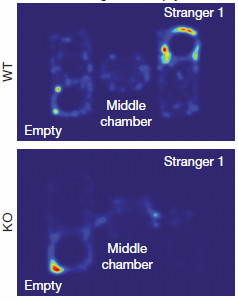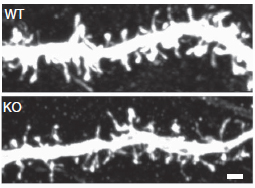Archived Content
The National Institute of Mental Health archives materials that are over 4 years old and no longer being updated. The content on this page is provided for historical reference purposes only and may not reflect current knowledge or information.
Mice with Autism-related Mutations Replicate Autism-like Behaviors
• Science Update
Mice bred to harbor mutations similar to those discovered in people with autism show autism-like repetitive behaviors and social impairments. The behaviors, triggered by deletions in a gene called SHANK3 , implicated in some cases of autism, were traced to weak neural connections for functions disturbed in autism.
NIMH grantee Guoping Feng, Ph.D., and colleagues at the Massachusetts Institute of Technology and Duke University, report on their findings March 20, 2011 online in the journal Nature.
"The ability to track in mice the mutations discovered in humans holds great promise for identifying both mechanisms and treatment targets for autism," said Thomas R. Insel, M.D., NIMH Director.
Background
The SHANK3 gene is located in an area of Chromosome 22 linked to autism. The protein it codes for is part of the machinery of communications between neurons in the striatum, a key relay station straddling the middle of the brain. These communications, through the chemical messenger glutamate, are involved in emotions, thinking and movement — functions affected in autism.
Mutant forms of the SHANK3 gene have been discovered in nearly one percent of people with autism and are suspected of causing their illness. Intellectual and speech impairments seen in the 22q13.3 deletion syndrome , which shares some symptoms with autism, have been traced to deficiencies in the SHANK3 protein.
The researchers had previously shown that a mutant form of a sister protein in the same complex produces a syndrome in mice evocative of obsessive compulsive disorder (OCD), which is also marked by repetitive behaviors. The complex is thought to form a critical scaffold supporting hundreds of other such post-synaptic proteins that enable brain cells to communicate.
To learn more about how disruptions in SHANK3 might lead to autism, Feng's team used genetic engineering to breed strains of mice missing parts of the gene.
Results
A strain of mice with the most severe SHANK3 deletions developed excessive grooming behavior, repetitively scratching away fur on their necks and faces — reminiscent of OCD-like repetitive behaviors seen in autism. Also like people with autism, these mice shunned social interactions with other animals and new social situations. Their brains harbored fewer — and weaker — than normal neural connections, or synapses, between the striatum and the brain's outer mantle, or cortex.
Significance
The findings, for the first time, show that mutations in SHANK3 lead to autism-like behaviors. The researchers are following-up clues that similar mutations in other synaptic proteins might also be causes of autism.
"We now have a very robust model with a known cause for autistic-like behaviors," said Feng. "We can figure out the neural circuits responsible for these behaviors, which could lead to novel targets for treatment."

A mouse with part of its SHANK3 gene knocked out (KO) spent less time in a chamber containing a social partner (Stranger 1) and more time in an empty cage, compared to a wild type (WT) control mouse. Movement of the animals was tracked by a heat sensing apparatus.

A neuronal extension in a mouse with part of its SHANK3 gene knocked out (KO) has sparser connections, or synapses, than a comparable area in a wild type (WT) control mouse.
Reference
Shank3 mutant mice display autistic-like behaviours and striatal dysfunction . Peça J, Feliciano C, Ting JT, Wang W, Wells MF, Venkatraman TN, Lascola CD, Fu Z, Feng G. Nature. 2011 Mar 20. [Epub ahead of print] PMID: 21423165
